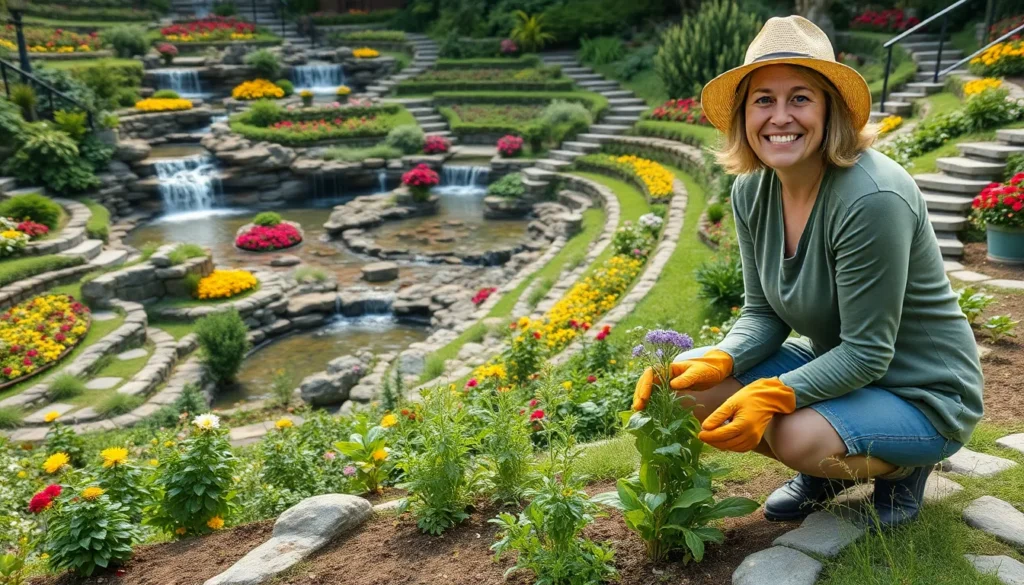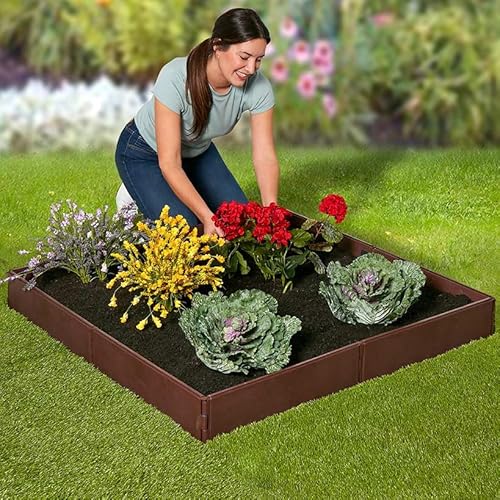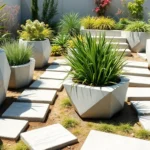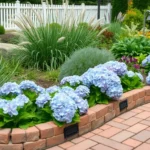We’ve all stared at that sloping backyard wondering how to transform an awkward hillside into something spectacular. Hillside gardening isn’t just about overcoming challenges – it’s about unlocking incredible opportunities that flat gardens simply can’t offer.
Sloped landscapes provide natural drama with cascading plants, terraced beds, and stunning vertical displays that create depth and visual interest. We’ll show you how to work with gravity instead of against it, turning drainage issues into water features and steep grades into show-stopping garden rooms.
Whether you’re dealing with a gentle slope or a dramatic incline, we’ve gathered proven hillside garden ideas that transform challenging terrain into your property’s most captivating feature. From retaining walls that double as seating to groundcover answers that prevent erosion while adding color, these strategies will help you create a hillside garden that’s both beautiful and functional.
Terraced Garden Beds for Maximum Growing Space
Terraced garden beds transform steep hillsides into productive growing spaces that maximize every square foot of your sloped industry. We’ll explore the essential components of successful terrace construction to help you create functional planting areas.
Creating Level Planting Areas
Measuring and planning your terraces requires careful consideration of slope gradient and desired bed depth. We recommend creating terraces between 3-6 feet wide to allow comfortable access for planting and maintenance. Start by marking contour lines across your slope using an A-frame level or water level to ensure each terrace sits perfectly horizontal.
Building terraces begins with cutting into the hillside to create flat surfaces. Cut material from the uphill side of each planned terrace and use it to build up the downhill edge. This method minimizes soil movement while creating stable, level planting beds. Most terraces work best with a slight backward slope of 1-2 degrees toward the hillside to prevent water runoff.
Soil preparation becomes crucial for terrace success since you’re working with disturbed earth. Add 2-4 inches of compost to each completed terrace bed to improve soil structure and drainage. Test soil pH after construction since cut and fill operations can expose different soil layers with varying nutrient levels.
Retaining Wall Materials and Construction
Stone retaining walls offer the most natural appearance and exceptional durability for terraced gardens. Natural fieldstone or quarried stone blocks create walls that blend seamlessly with hillside environments. These materials typically last 50-100 years with minimal maintenance when properly installed with adequate drainage behind them.
Timber retaining walls provide an affordable option that’s perfect for DIY installation. Pressure treated lumber rated for ground contact works well for walls up to 4 feet high. Use 6×6 or 8×8 posts set 2-3 feet into the ground with horizontal boards secured between them. Expect timber walls to last 15-25 years depending on your climate.
Concrete block systems deliver maximum strength for taller retaining walls exceeding 4 feet. Interlocking concrete blocks require no mortar and include built in drainage features. These modular systems cost $15-25 per square foot installed and handle heavy soil loads better than other materials.
| Material Type | Cost per Sq Ft | Lifespan | Max Height | DIY Friendly |
|---|---|---|---|---|
| Natural Stone | $25-40 | 50-100 years | 8+ feet | Moderate |
| Pressure Treated Timber | $8-15 | 15-25 years | 4 feet | High |
| Concrete Blocks | $15-25 | 30-50 years | 8+ feet | High |
| Poured Concrete | $20-35 | 50+ years | No limit | Low |
Drainage Considerations for Terraced Design
French drains behind retaining walls prevent water buildup that can cause structural failure. Install a 6-inch wide trench filled with gravel directly behind each retaining wall. Place perforated drain pipe at the bottom of this trench and cover with industry fabric before backfilling with soil.
Surface drainage channels between terraces direct water flow and prevent erosion. Create shallow swales or install decorative drainage channels at the junction between terrace levels. These features should slope gently toward designated drainage areas or rain gardens at the bottom of your hillside.
Weep holes in solid retaining walls allow water to escape and reduce hydrostatic pressure. Space 4-inch diameter weep holes every 6-8 feet along the wall base. Install gravel backfill extending 12 inches above and below each weep hole to prevent clogging with soil particles.
Rock Gardens That Embrace Natural Slopes
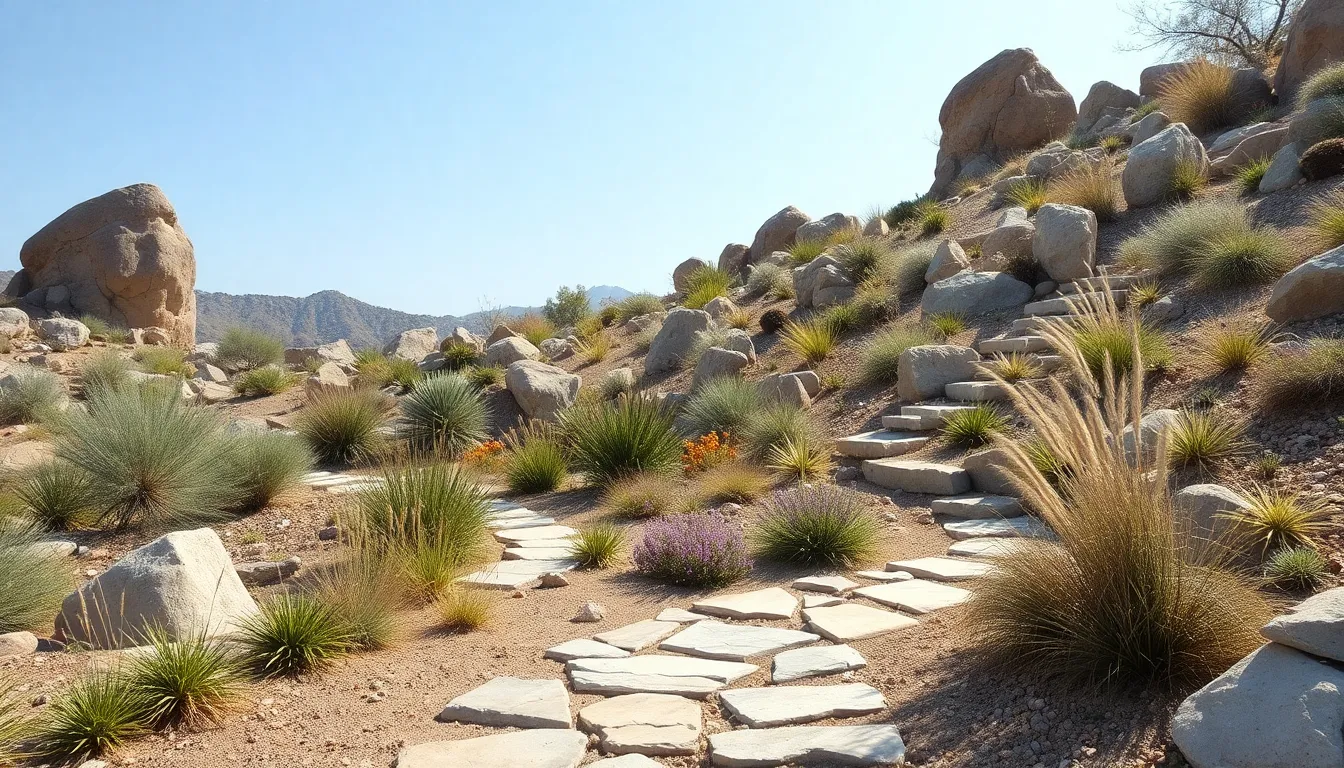
Rock gardens transform challenging hillside terrain into stunning focal points that celebrate the natural contours of your industry. We’ll explore how to work with existing rocks and add complementary materials to create a cohesive design that prevents erosion while improving visual appeal.
Selecting Drought-Tolerant Plants
Drought-tolerant plants with deep root systems become essential allies in stabilizing your hillside rock garden. Coneflower stands out as an excellent choice, developing extensive underground networks that anchor soil and prevent displacement. Ornamental grasses create dense mat-like root structures that effectively reduce erosion while adding texture and movement to rocky areas.
Self-sowing perennials offer long-term benefits by naturally spreading throughout your rock garden and softening harsh stone edges. These plants require minimal watering once established, making them perfect for slopes where irrigation can be challenging. Large evergreens provide depth and year-round structure while their root systems contribute to overall soil stability.
Strategic Boulder Placement
Strategic boulder positioning creates natural focal points that enhance your hillside’s existing topography. Large boulders serve dual purposes as dramatic visual anchors and practical seating areas for enjoying your garden views. Smaller rocks can be arranged in visually appealing clusters that guide the eye through your industry.
Repositioning existing rocks into stepped formations helps create natural platforms for planting while improving accessibility. This technique allows you to work with your slope’s natural drainage patterns rather than fighting against them. Boulders also act as natural windbreaks and microclimates that protect more delicate plants.
Creating Natural-Looking Stone Pathways
Natural stone pathways wind gracefully through hillside rock gardens, maintaining the organic feel of your industry. Stepping stones with textured surfaces provide essential traction for safe navigation on sloped terrain. We recommend spacing stones according to natural walking patterns to create comfortable movement through your garden.
Incorporating pea gravel between pathway stones prevents runoff while maintaining a consistent color palette throughout your design. This approach helps blend hardscape elements seamlessly with planted areas. Hypertufa materials work exceptionally well when mixed with natural limestone, creating artificial stone elements that weather beautifully and complement existing rock formations.
Cascading Water Features for Sloped Landscapes
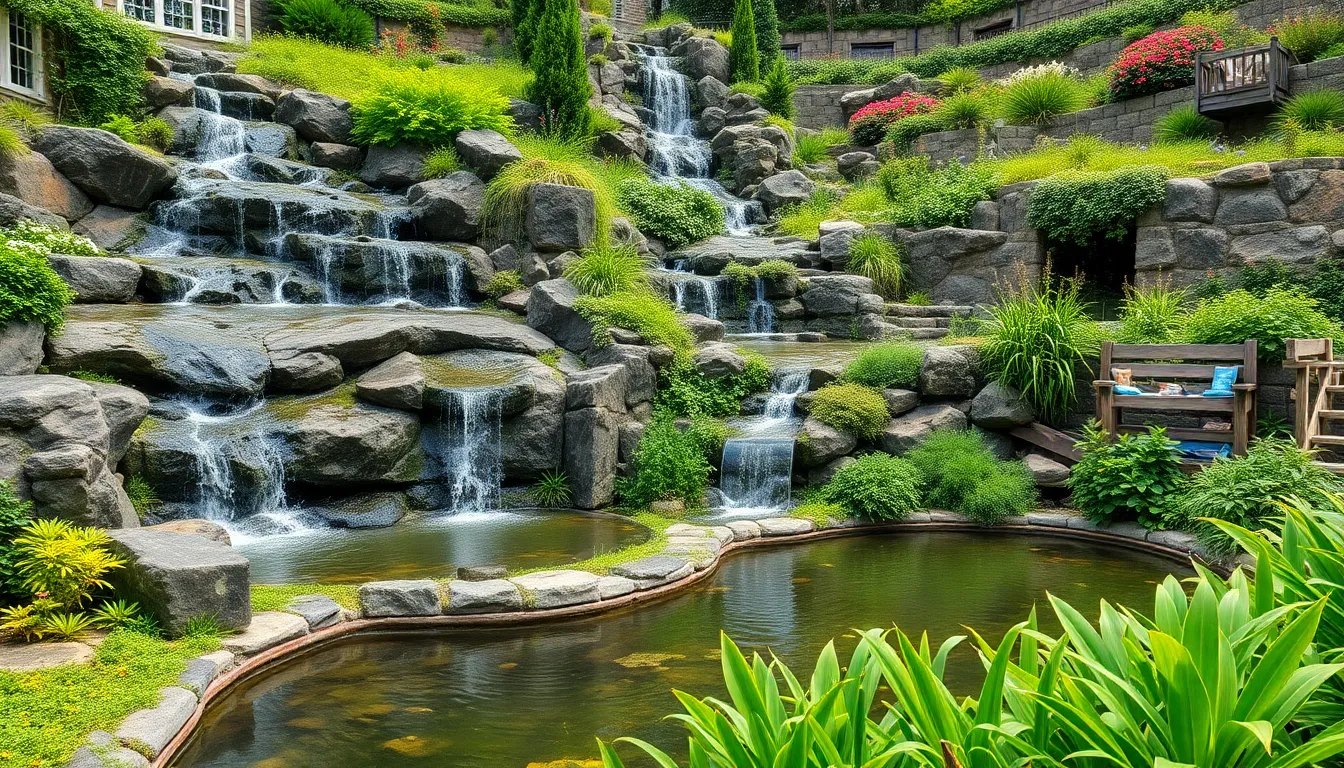
Water features transform challenging hillside terrain into stunning focal points that naturally complement your garden’s elevation changes. We can create ever-changing visual interest while addressing practical drainage concerns through strategic water element placement.
Installing Hillside Streams and Waterfalls
Installing hillside streams begins with careful planning to control water flow and prevent erosion throughout your sloped industry. We recommend using natural or artificial rock formations to guide the water’s path down the slope, creating visually captivating cascading effects that enhance your garden’s aesthetic appeal.
Design considerations must include proper water flow management to protect your hillside from soil displacement. We suggest incorporating strategic rock placements that direct water naturally while creating beautiful visual breaks along the stream’s journey.
Maintenance requirements for hillside water features include regular cleaning to keep water free of debris and prevent blockages. We need to check pumps and filtration systems monthly during active seasons to ensure optimal performance and water clarity.
Professional installation often proves worthwhile for complex hillside stream projects involving electrical work or extensive excavation. We can create DIY friendly versions using pre-formed stream sections and flexible liners for smaller scale installations.
Pond Placement on Sloped Terrain
Pond placement works best at the bottom of slopes where water naturally collects, helping manage runoff while creating a beautiful focal point. We can use these natural collection points to our advantage by positioning ponds to catch and filter rainwater flowing down the hillside.
Design integration with surrounding plant life maximizes both aesthetic appeal and ecological benefits for your sloped terrain. We recommend incorporating moisture loving plants around pond edges to create seamless transitions between water features and hillside plantings.
Multiple pond levels can be created using a series of smaller water features connected by streams or waterfalls. We often design terraced pond systems that step down the hillside, creating dramatic visual impact while managing water flow effectively.
Construction considerations include proper liner installation and edge reinforcement to handle potential soil movement on slopes. We need to ensure adequate depth and filtration capacity to maintain healthy water conditions in hillside pond installations.
Managing Water Flow and Erosion Control
Managing water flow requires strategic planning to direct runoff safely while protecting your hillside garden from soil loss. We use deep rooted plants and engineered answers to create effective erosion prevention systems that maintain slope stability.
Erosion prevention strategies include selecting native plants with extensive root systems that naturally stabilize soil on sloped terrain. We recommend combining groundcovers, shrubs, and trees to create layered root networks that hold soil in place during heavy rainfall.
Water management features like terracing and retaining walls help control flow patterns while creating functional garden spaces. We can carry out French drains, surface channels, and strategically placed rocks to guide water movement and prevent concentrated runoff damage.
Plant selection for moisture areas should focus on species that thrive in wet conditions near water features and drainage zones. We choose plants like sedges, ferns, and moisture loving perennials that help filter runoff while adding beauty to problem areas.
Integration of hardscape elements with plant materials creates comprehensive erosion control systems that look natural and function effectively. We design these combinations to work together, using rocks, plants, and water features as unified slope management answers.
Ground Cover Solutions for Steep Slopes
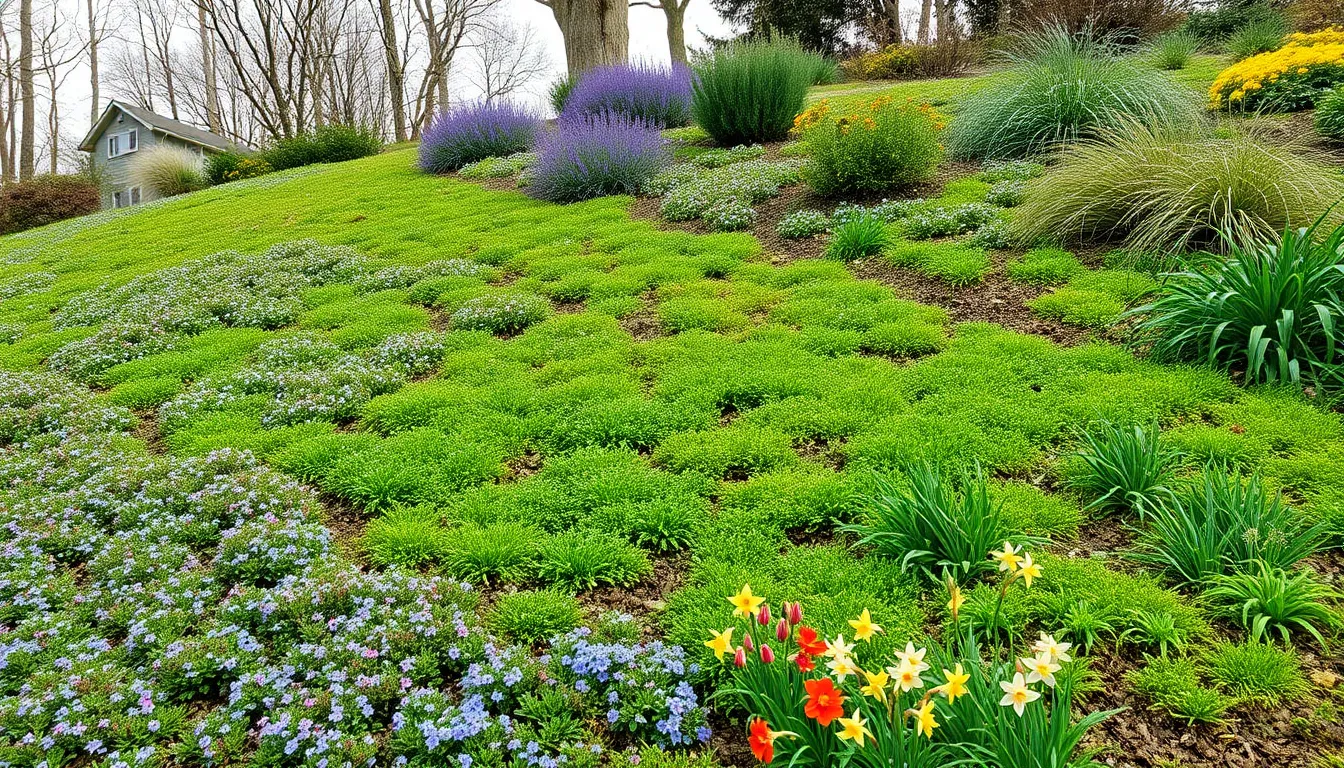
We’ve found that selecting the right ground cover can transform challenging steep slopes into stable, attractive industry features. Plants that spread naturally and develop strong root systems offer the best solution for erosion control while reducing maintenance needs.
Best Plants for Erosion Prevention
Native grasses like coneflower and ornamental grasses work exceptionally well because they develop deep root systems that anchor soil effectively. These plants create natural barriers against water runoff while establishing themselves quickly on challenging terrain.
Shrubs such as boxwood and juniper provide excellent structural support for hillside stability. We recommend these woody plants because they anchor soil through extensive root networks and offer year-round coverage that prevents erosion during harsh weather conditions.
Creeping Thyme excels at erosion control since it spreads quickly across surfaces and can handle foot traffic. This hardy ground cover establishes dense root mats that hold soil particles together while providing aromatic foliage.
Vinca minor, commonly known as Periwinkle, forms dense mats that effectively prevent soil erosion. This evergreen ground cover thrives in various light conditions and creates impenetrable coverage that water cannot easily penetrate.
Corydalis offers unique benefits as a self-sowing perennial that fills gaps in rocky hillside areas. We appreciate this plant’s ability to establish itself in challenging spots where other varieties struggle to take hold.
Low-Maintenance Spreading Varieties
Creeping Juniper stands out as an exceptional choice because it spreads quickly while requiring minimal care once established. This evergreen variety tolerates drought conditions and provides consistent coverage throughout all seasons.
Sedum varieties offer outstanding drought tolerance and spread easily across sloped surfaces. These succulent plants store water in their leaves, making them perfect for areas where irrigation is challenging or impractical.
Creeping Raspberry (Rubus calycinoides) provides fast-spreading coverage that maintains excellent soil stability. We’ve observed this variety creating dense mats within one growing season while requiring little ongoing maintenance.
Phlox subulata, known as Creeping Phlox, delivers vibrant spring color while stabilizing soil through aggressive spreading habits. This perennial forms thick carpets that suppress weeds and prevent erosion effectively.
Seasonal Color Options for Hillside Coverage
Spring coverage begins with Creeping Phlox, Crocus, and Daffodils that provide early season color when hillsides emerge from winter dormancy. These early bloomers establish visual interest before other plants begin their growing cycles.
Summer brings vibrant displays through Black-eyed Susans, Daylilies, and Coreopsis that offer sustained color throughout the warmest months. We recommend these varieties because they maintain their appearance during periods of intense heat and limited rainfall.
Fall coverage extends the growing season with Asters, Sedum, and ornamental grasses that provide late-season color as other plants begin dormancy. These varieties often display their most dramatic colors during cooler autumn temperatures.
Winter interest continues through Wintergreen, Holly, and evergreen shrubs that maintain year-round coverage. We value these plants for their ability to provide structure and color during months when deciduous varieties are dormant.
Stepped Pathway Systems Through Hillside Gardens
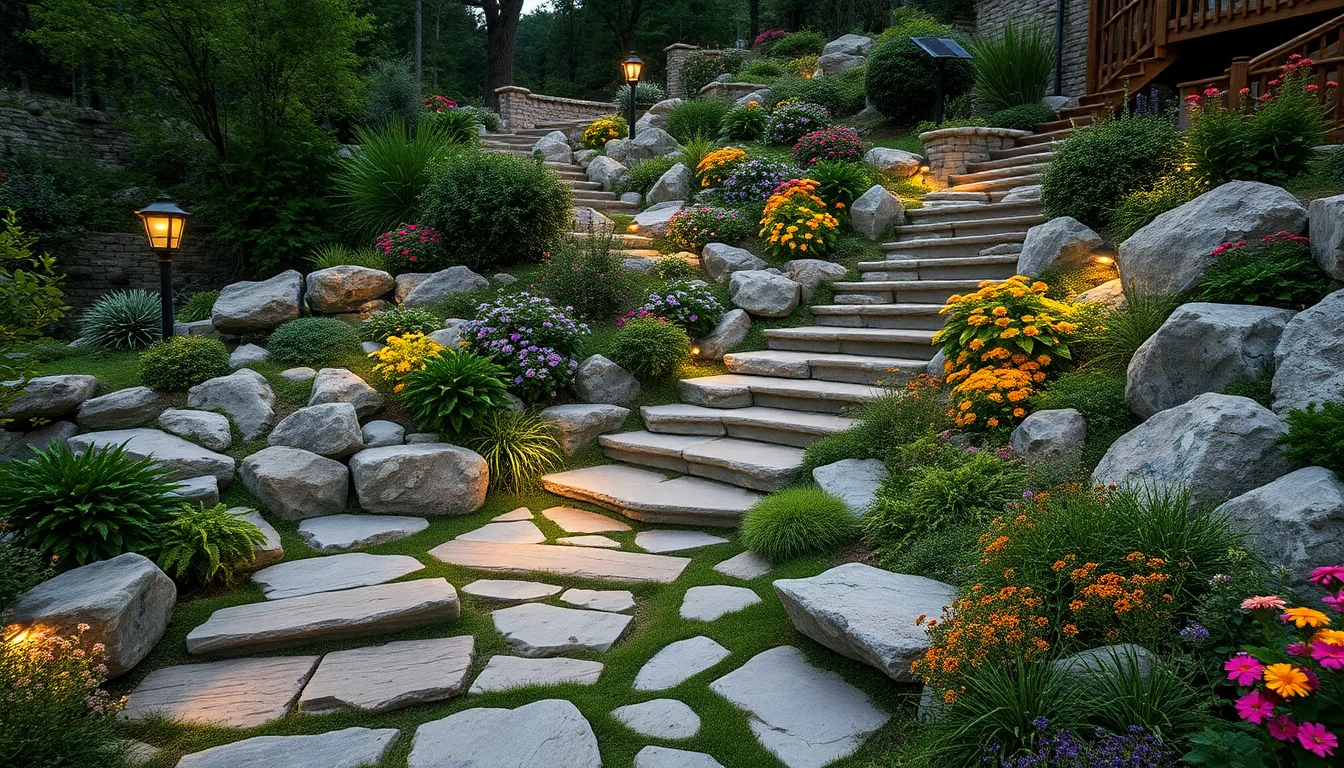
Creating pathways through hillside gardens requires thoughtful design to ensure both safety and visual appeal. Well-planned stepping systems transform challenging slopes into accessible garden features that blend seamlessly with the natural industry.
Natural Stone Step Construction
Natural stone construction provides the most durable and visually appealing pathway solution for hillside gardens. Local materials like flagstone, bluestone, and fieldstone blend naturally with surrounding terrain while offering long-lasting stability. Larger stone slabs work exceptionally well as individual steps or broader platforms that create resting points throughout the climb.
Stone selection should prioritize textured surfaces that provide adequate traction during wet conditions. Installing these materials requires proper foundation preparation to prevent shifting over time. Pea gravel serves as an excellent accent material between stone elements, helping prevent water runoff while maintaining a cohesive color palette throughout the pathway system.
Professional installation typically ensures proper drainage underneath each stone element. We recommend using stones that are at least 2 inches thick for adequate weight distribution and stability.
Wooden Stairway Integration
Wooden stairways offer a rustic aesthetic that complements natural garden environments while providing structured access through steep areas. Pressure-treated lumber or naturally rot-resistant woods like cedar ensure longevity in outdoor conditions. These installations require secure anchoring systems that penetrate deeply into hillside soil for maximum stability.
Integration with existing industry features creates the most appealing results. Combining wooden steps with surrounding stone elements or planted borders helps soften the hardscape appearance. Strategic placement of wooden railings provides necessary support without overwhelming the natural garden design.
We suggest incorporating landing platforms every 8-10 steps to reduce fatigue and create opportunities for garden viewing. Staining or sealing wooden elements annually maintains their appearance and extends their functional lifespan.
Safety Railings and Lighting Options
Safety railings become essential on slopes exceeding 30 degrees or where pathway width restricts safe passage. Wood and metal materials both offer reliable support options, with metal providing superior durability in harsh weather conditions. Installation height should reach 36-42 inches for optimal user safety and comfort.
Lighting systems dramatically improve pathway usability during evening hours while adding ambient beauty to hillside gardens. Solar-powered fixtures eliminate electrical wiring complications and provide sustainable illumination throughout the night. Strategic placement every 6-8 feet ensures adequate visibility without creating harsh lighting effects.
We recommend combining pathway lighting with accent illumination for nearby garden features. Motion-activated options conserve energy while providing security benefits for frequently used routes.
Native Plant Gardens for Hillside Sustainability
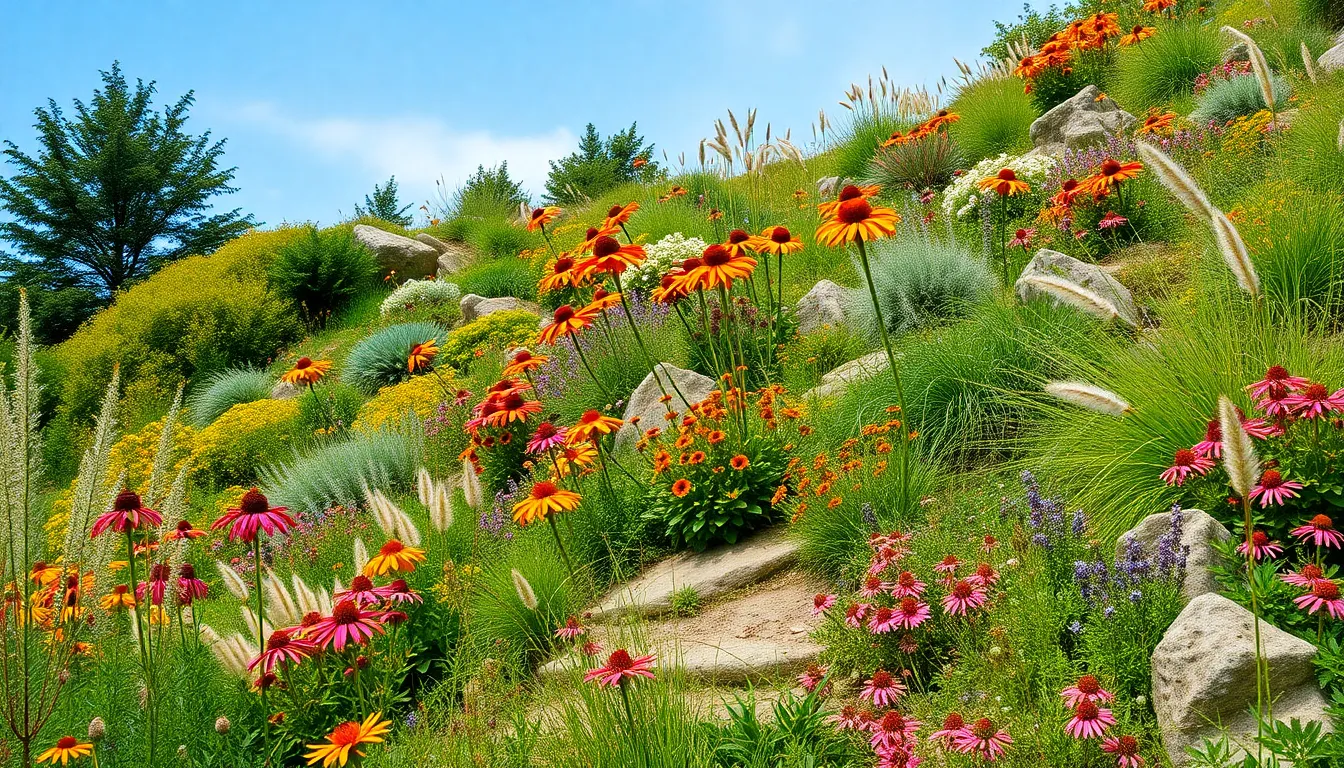
Native plants offer the most sustainable approach to hillside gardening by working with your slope’s natural conditions. We’ll explore how to select and establish plants that thrive without intensive maintenance while supporting local ecosystems.
Regional Plant Selection Strategies
Microclimate assessment forms the foundation of successful native plant selection on hillsides. Different areas of your slope receive varying amounts of sun, shade, and moisture, requiring strategic plant placement based on these conditions. We recommend mapping your hillside’s microclimates before selecting any plants.
Native plant combinations create the most resilient hillside gardens. Midwest gardeners can establish stunning displays using coneflowers and black-eyed Susans, while Southwest slopes thrive with California poppies and sagebrush. These regional natives adapt naturally to local soil and weather patterns.
Diverse plant structures provide comprehensive slope stabilization. We suggest incorporating perennials like native wildflowers, ornamental grasses such as buffalo grass, and shrubs including elderberry or serviceberry. This variety creates different root depths and growth patterns that work together to prevent erosion.
Water-Wise Landscaping Techniques
Rain gardens transform hillside water management into attractive features. These strategically placed depressions use your slope’s natural drainage to direct rainwater while filtering out pollutants. We position rain gardens at natural collection points to maximize their effectiveness.
Bioswales extend water management across longer hillside sections. These shallow channels follow your slope’s contours, slowing water flow and allowing deeper soil infiltration. Native sedges and rushes planted within bioswales create living filters that clean runoff naturally.
Permeable hardscape materials support sustainable water absorption. We replace traditional concrete with permeable pavers that allow rainwater to soak into the ground rather than creating runoff. This approach reduces erosion while maintaining accessible pathways through your hillside garden.
Wildlife Habitat Creation on Slopes
Diverse native plantings establish complete wildlife ecosystems on hillsides. We select plants that provide food sources like native berries, shelter options such as dense shrubs, and nesting sites including hollow-stemmed plants. This comprehensive approach supports birds, beneficial insects, and small mammals.
Structural habitat elements enhance natural plant communities. Rock piles create shelter for reptiles and amphibians, while strategically placed birdhouses support cavity-nesting species. We integrate these features naturally into the slope’s existing topography.
Minimal intervention preserves existing wildlife corridors. We maintain natural vegetation wherever possible and limit landscaping disturbance to essential areas only. This approach protects established animal pathways while allowing new plantings to integrate gradually with existing habitats.
Raised Bed Systems for Hillside Gardening
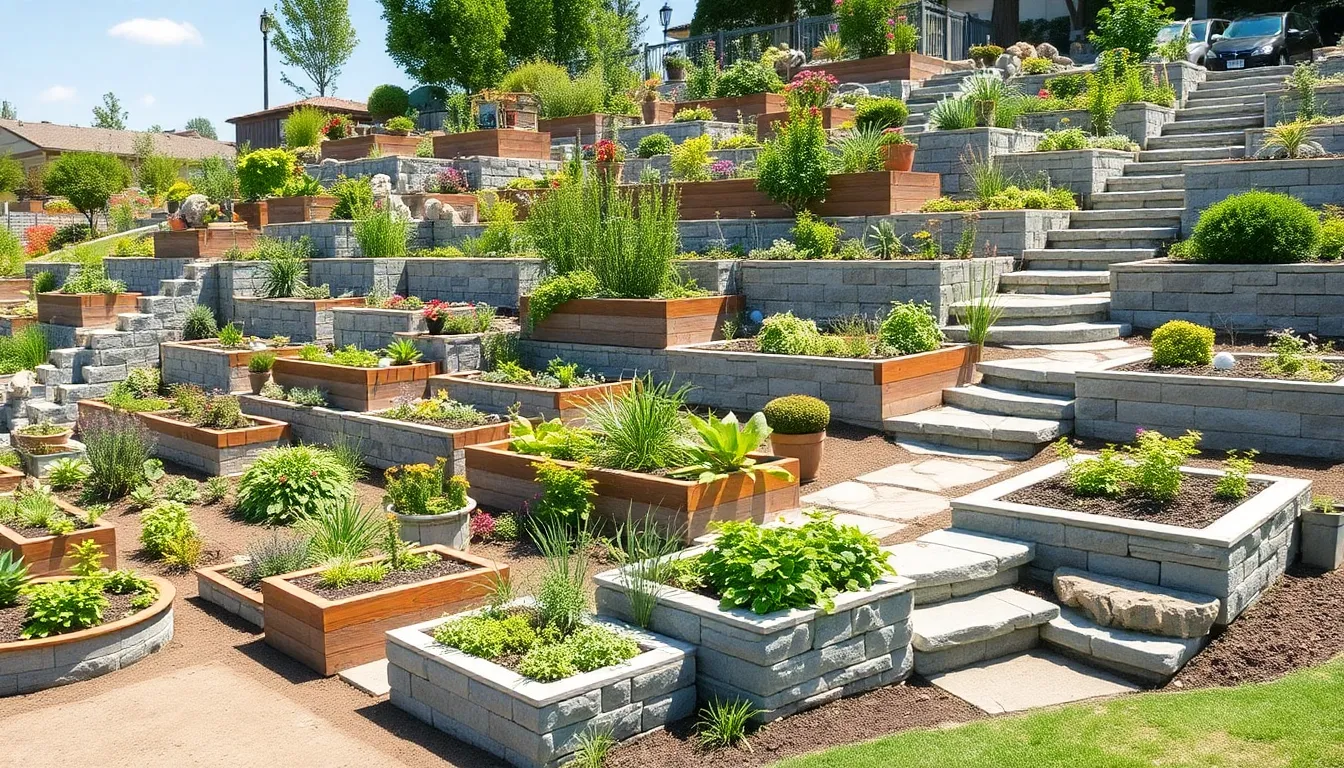
Creating functional growing spaces on slopes requires strategic planning and the right structural systems. We’ll explore proven answers that maximize planting potential while addressing the unique challenges of hillside terrain.
Modular Planting Box Answers
Pre-fabricated modular systems offer unmatched flexibility for hillside installations. These units can be easily assembled and arranged to follow your slope’s natural contours without extensive site preparation. Sectional planting approaches allow us to divide hillsides into manageable zones, with each modular box containing different plant types or garden features that complement the overall design.
Privacy screening installations serve dual purposes on hillsides by creating visual barriers while stabilizing soil through strategic root systems. We position these modular boxes to form natural privacy walls that follow the slope’s natural flow. Container-based systems provide additional versatility through removable planting boxes that can be repositioned seasonally or as plants mature.
Interlocking designs ensure structural stability when connecting multiple units across varying slope angles. These systems typically feature built-in drainage channels and reinforcement brackets that prevent shifting during heavy rainfall or soil expansion.
Soil Retention and Drainage Methods
Stone retaining walls provide the most durable soil retention solution for hillside raised beds. We construct these barriers using materials like natural stone, brick, or concrete blocks that can withstand important soil pressure and weather exposure. French drain systems work alongside retaining walls to manage water runoff and prevent soil saturation that could compromise structural integrity.
Drainage channel installation directs excess water away from planting areas through strategically placed surface channels. We incorporate these systems during initial construction to prevent erosion and maintain optimal soil moisture levels. Weep hole placement in retaining walls allows controlled water release while maintaining soil stability.
Terracing techniques create multiple flat planting surfaces that reduce soil erosion and improve water retention. This method involves building stepped retaining walls that follow the hillside’s natural grade while creating level growing areas between each tier.
Accessibility Improvements for Sloped Gardens
Step pathway construction transforms challenging hillside terrain into navigable garden spaces through carefully planned stone or concrete steps. We position these pathways to provide safe access to all raised bed areas while maintaining visual appeal. Handrail installations enhance safety along steep sections and provide stability for gardeners carrying tools or plants.
Elevated walkway systems offer barrier-free access to hillside raised beds through raised platforms that bridge difficult terrain. These structures can be built using treated lumber or composite materials that withstand weather exposure. Gradual slope modifications reduce steep angles through strategic grading that makes hillside raised beds more accessible without compromising drainage.
Platform landing areas provide rest points and tool storage spaces between raised bed sections on longer hillside installations. We design these areas to accommodate wheelbarrows and garden carts while serving as staging areas for planting and maintenance activities.
Ornamental Grass Landscapes for Hillside Appeal
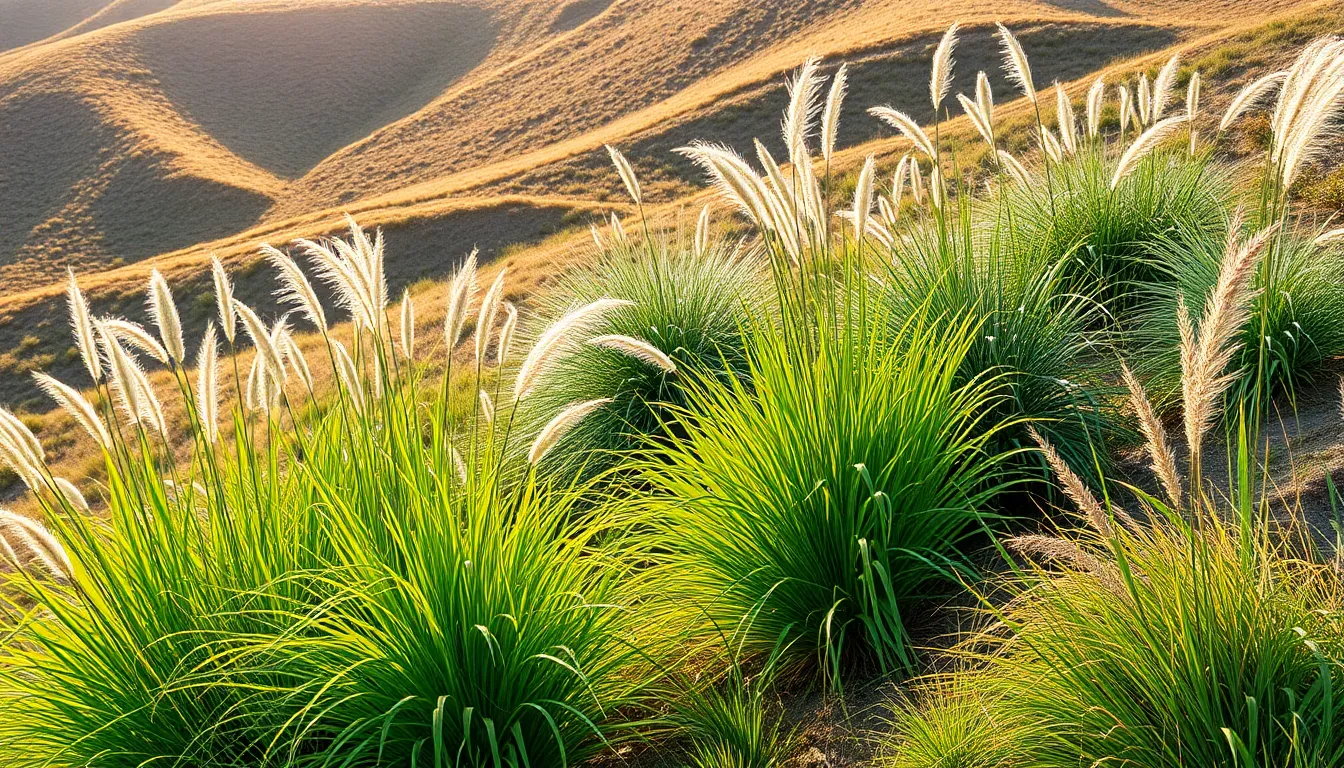
Grasses bring natural movement and texture to sloped terrain while providing essential soil stability. We’ve found that ornamental varieties excel on hillsides because they develop extensive root systems that anchor soil and prevent erosion.
Wind-Resistant Grass Varieties
Pampas grass stands as our top recommendation for exposed hillside locations due to its exceptional wind tolerance. This robust variety grows 6-10 feet tall and features feathery plumes that sway gracefully without breaking in strong gusts.
Blue oat grass offers another reliable option for windy slopes with its steel-blue foliage and compact 2-3 foot height. We appreciate this variety’s low maintenance requirements and ability to maintain its form even in challenging conditions.
Fountain grass provides excellent wind resistance while adding cascading texture to hillside plantings. Its arching habit creates natural movement that complements the slope’s contours without requiring frequent replacement or repair.
Seasonal Interest and Texture Combinations
Spring brings vibrant new growth as ornamental grasses emerge with fresh green shoots and developing seed heads. We combine early bloomers like Clethra alnifolia with emerging grass foliage to create layered seasonal displays.
Summer showcases grasses at their peak with full, lush foliage and dramatic plumes reaching maximum height. Pairing varieties like fountain grass with Ceanothus (California lilac) creates striking color contrasts during this growing season.
Fall transforms hillside grass gardens into golden landscapes as seed heads mature and foliage shifts to warm amber tones. We’ve observed that this seasonal change provides the most dramatic visual impact on sloped terrain.
Winter maintains structural interest through dried stalks and persistent seed heads that catch frost and create sculptural silhouettes. These dormant grasses continue providing erosion control even when not actively growing.
Maintenance Requirements for Sloped Grass Gardens
Irrigation systems work best when we install drip lines that deliver water directly to root zones without creating runoff. This targeted approach prevents soil erosion while ensuring adequate moisture reaches each plant.
Pruning schedules focus on light trimming in spring and fall to maintain shape and encourage new growth. We cut back ornamental grasses to 6 inches above ground level before new shoots emerge.
Mulching applications help retain soil moisture and suppress weeds while adding an extra layer of erosion protection. Organic mulches like shredded bark work particularly well around grass plantings on slopes.
Materials selection for supporting structures emphasizes durability and stability on sloped terrain. We recommend using treated timber or natural stone for any retaining elements that complement grass plantings.
Fruit and Vegetable Gardens on Hillside Terrain
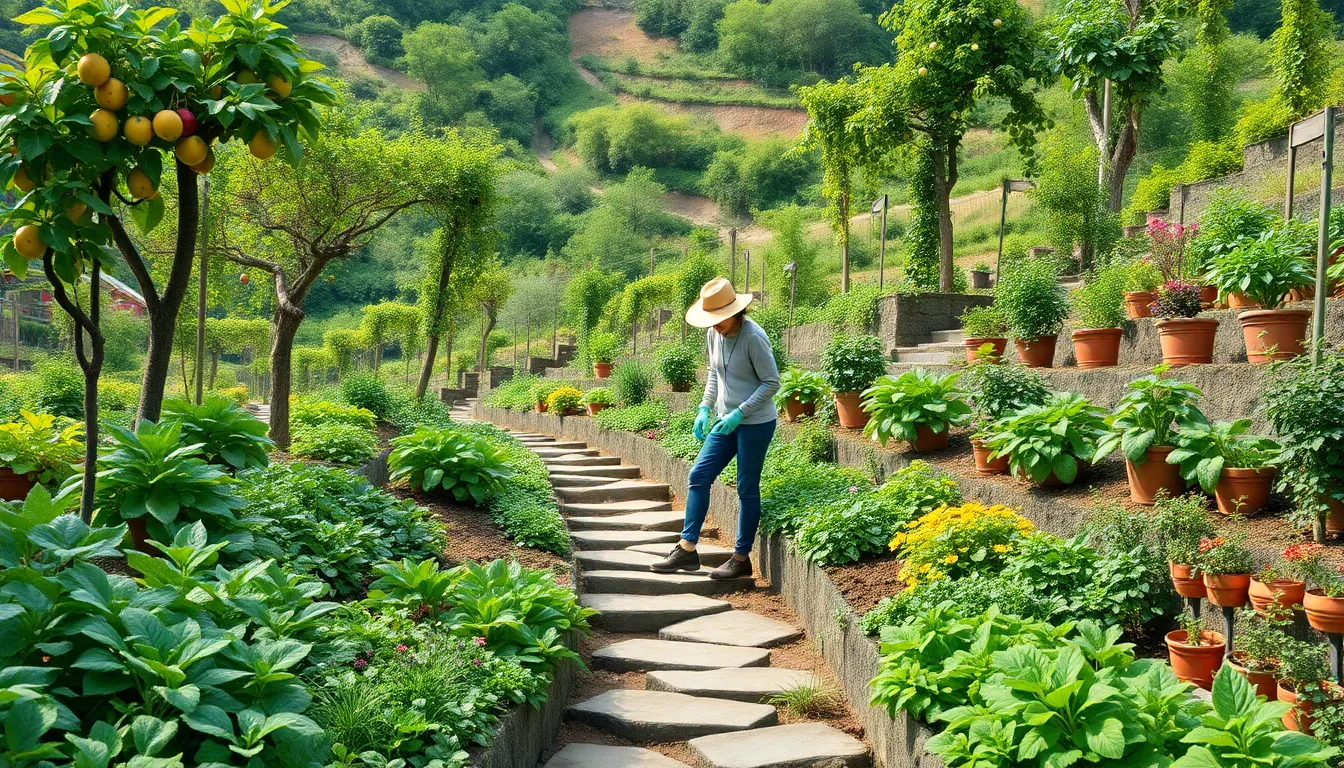
Hillside terrain offers unique opportunities for productive fruit and vegetable gardens when we approach the challenges with proper planning. Creating level planting areas through terracing techniques helps reduce erosion while improving accessibility for our growing needs.
Optimal Crop Selection for Slopes
Fruit trees with deep root systems anchor soil effectively while providing delicious harvests on hillside terrain. Apple and pear varieties establish strong root networks that prevent erosion and thrive in sloped conditions. Vegetables like zucchini and squash spread across slopes with their extensive vine systems, creating natural ground cover that stabilizes soil. Climbing vines such as grapes and kiwi work exceptionally well on hillsides, as they use vertical space while their roots penetrate deep into the slope.
Root vegetables benefit from the improved drainage that slopes naturally provide, making carrots and potatoes excellent choices for terraced sections. Berry bushes like blueberries and blackberries create living retaining walls when planted in rows along contour lines. Herbs such as rosemary and thyme establish quickly on slopes and require minimal maintenance once established.
Irrigation Systems for Hillside Produce
Drip irrigation delivers water directly to plant roots while minimizing runoff and waste on sloped terrain. Installing drip lines along contour paths ensures even water distribution without creating erosion channels down the slope. Emitter spacing adjustments accommodate different plant water requirements while maintaining consistent soil moisture levels.
Micro-sprinkler systems work well for larger fruit trees and established vegetable beds on gentler slopes. Timer-controlled irrigation prevents overwatering while ensuring plants receive adequate moisture during critical growing periods. Water collection systems at the bottom of slopes capture runoff for reuse in drier areas of the garden.
Harvesting Considerations for Sloped Gardens
Stepping stones create safe pathways for accessing all areas of our hillside produce gardens during harvest time. Installing these stones along natural contour lines provides stable footing while minimizing soil compaction. Terraced pathways allow us to move harvesting equipment and containers efficiently between different elevation levels.
Regular maintenance practices like mulching preserve soil integrity and prevent erosion during frequent harvesting activities. Pruning fruit trees and removing spent vegetable plants helps maintain clear access routes throughout the growing season. Harvesting baskets with shoulder straps keep our hands free for safe navigation on sloped terrain while collecting produce.
Conclusion
We’ve shown you that hillside gardens aren’t just possible—they’re an opportunity to create something truly spectacular. Your sloped terrain can become the foundation for a ever-changing industry that combines beauty with functionality.
Whether you choose terraced beds cascading water features or ornamental grass displays the key lies in working with your slope rather than against it. Each challenge becomes a design opportunity when approached with the right techniques and plant selections.
Remember that successful hillside gardening is about patience and planning. Start with one area focus on proper drainage and soil stability then expand your vision as you gain confidence with the terrain.
Your hillside garden will reward you with unique views dramatic plantings and a industry that truly stands apart from traditional flat gardens.
Frequently Asked Questions
What are the main advantages of hillside gardening?
Hillside gardens offer unique opportunities that flat gardens cannot achieve, including cascading plant displays, terraced beds, and vertical visual interest. Sloped terrain allows for creative water features, natural drainage solutions, and stunning focal points. The vertical space maximizes planting area while creating dramatic garden rooms and scenic viewpoints.
How do I prevent erosion on my hillside garden?
Use deep-rooted native plants, groundcover, and ornamental grasses to stabilize soil naturally. Install retaining walls with proper drainage, create terraced beds, and incorporate French drains. Strategic boulder placement and stepped stone formations also help control water flow while adding visual appeal to your slope.
What materials work best for hillside retaining walls?
Natural stone offers durability and aesthetic appeal but requires professional installation. Timber is cost-effective and DIY-friendly but needs regular maintenance. Concrete blocks provide strength and versatility at moderate cost. Choose materials based on your budget, slope steepness, and desired lifespan of the installation.
Which plants are ideal for steep slopes?
Select drought-tolerant plants with deep root systems like coneflowers, ornamental grasses, and native groundcovers. Sprawling vegetables, climbing vines, and established fruit trees work well on terraced areas. Wind-resistant grass varieties such as pampas grass and fountain grass provide stability and year-round visual interest.
How do I create proper drainage on hillside terraces?
Install French drains behind retaining walls, add weep holes for water escape, and create surface drainage channels. Position terraces to work with natural water flow patterns. Use gravel layers in construction and ensure proper soil grading to prevent water buildup and structural damage.
Can I grow vegetables and fruits on a hillside?
Yes, hillside terrain is excellent for productive gardens when properly terraced. Deep-rooted fruit trees, sprawling vegetables like squash, climbing vines, and herbs thrive on slopes. Use drip irrigation systems for efficient watering and create safe pathways for harvesting and maintenance access.
What’s the best way to build pathways on slopes?
Create stepped stone pathways using textured materials and pea gravel for traction. Install handrails for safety on steep sections and add platform landing areas for rest stops. Use modular systems that follow the slope’s natural contours while maintaining accessibility and visual appeal.
How do I incorporate water features into hillside gardens?
Position ponds at the bottom of slopes to collect runoff and create focal points. Install cascading streams and waterfalls that work with natural drainage patterns. Plan for proper water flow management and erosion prevention. Consider DIY options like simple spillways for budget-friendly installations.

